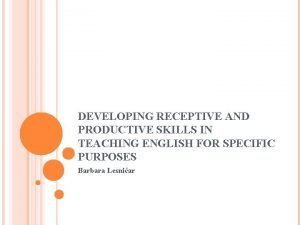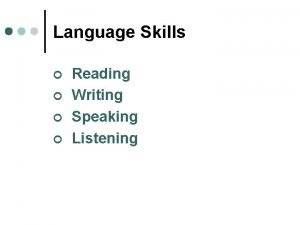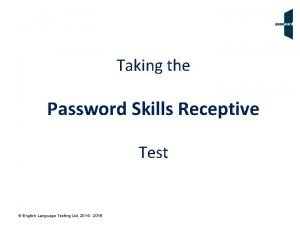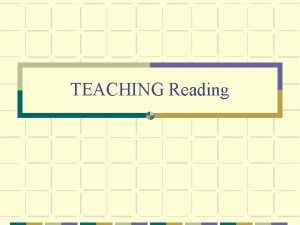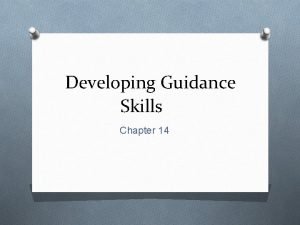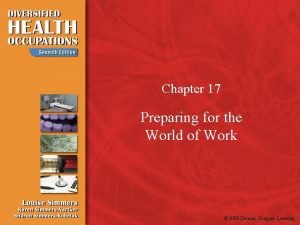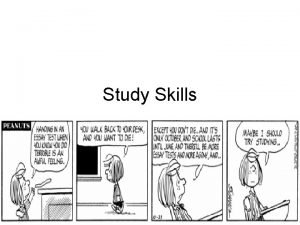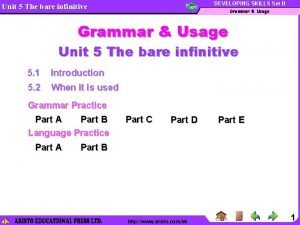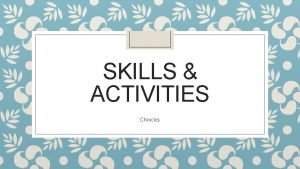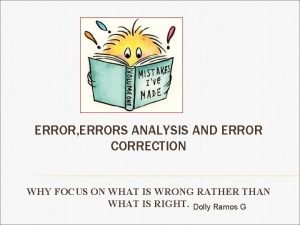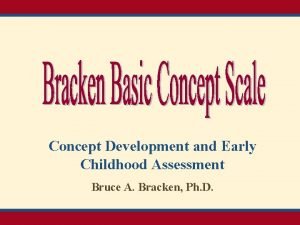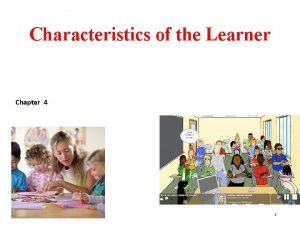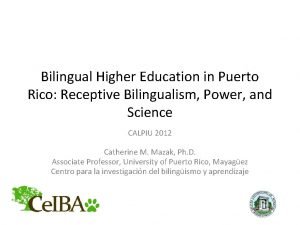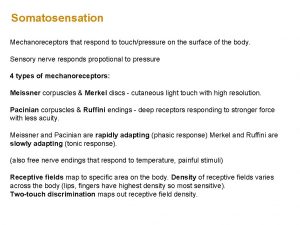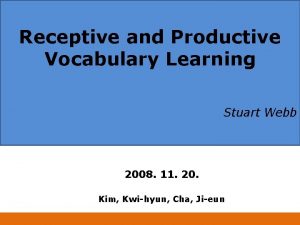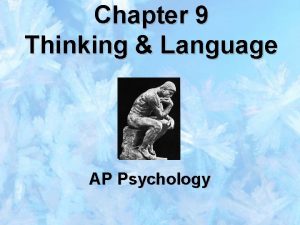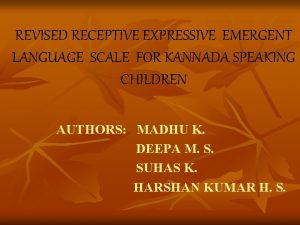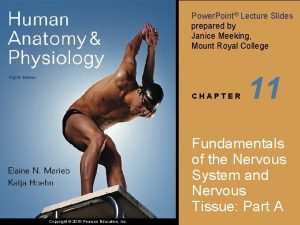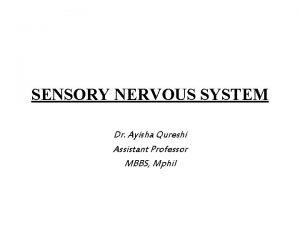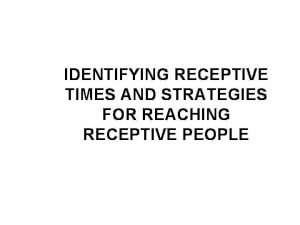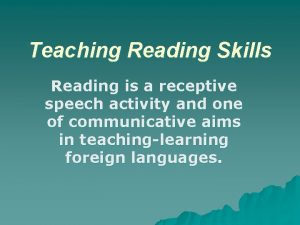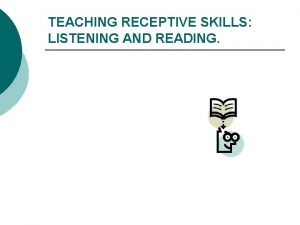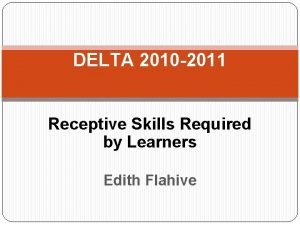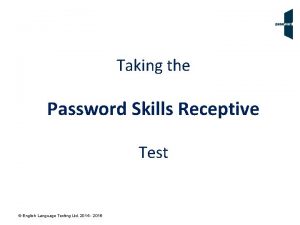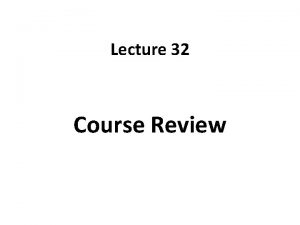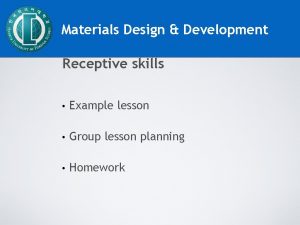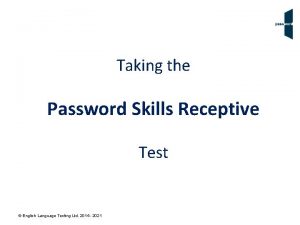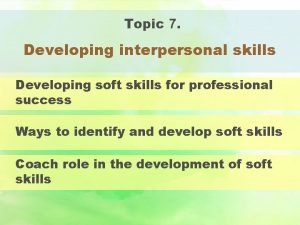Developing receptive skills Reading Reasons for reading Reading



























- Slides: 27

Developing receptive skills: Reading

Reasons for reading • Reading – a genuinely complex skill, useful as a source for both vocabulary expansion AND grammar awareness – through ´grammar in context´ ; when chosen properly, in enhances speaking, too, and creative thinking of the learners (Richterová , 2015). • Reading has positive effect on spelling, writing, punctuation. Reading stimulates language acquisition. (Harmer, 2007)

• • Motivation/reason – to be able to read for our careers, for study purposes, pleasure; good texts introduce interesting topics and encourage the students to discuss them (Harmer, 2007, 99).

• Reading – difference between reading to oneself and reading aloud; reading to oneself another receptive skill; • similar procedures can be used to help the learners as with listening (the task → feedback circle and other recommendations adaptable) • Obvious difference – people read at different speed + in different ways (x the recording) → individual learners control their speed and what they are looking at; (Scrivener, 2011)

• extensive reading (reading for pleasure – joyful reading) • intensive reading (detail focus – reading texts used mainly in classroom) (Harmer, 2007, 99)

• Ideally – we would like the learners to read authentic texts (those which are not written especially for language learners), but to balance the level of the students with the requirement – simplified graded readers are used, providing the comprehensible input. (Harmer, 2007, 100)

Difficulties when reading in a foreign language: • We may not know enough vocabulary; • We may need the dictionary all the time; • It´s very slow; it takes a long time to get through a few sentences; • We sometimes get to the stage where we understand all the individual words, but the whole text eludes us – makes us feel confused; • As it is slow, the pleasure or interest in the subject matter may soon get lost;

• Advice – we should raise the learners´ awareness of the fact that it´s not always essential to understand every word – so, practising some reading techniques may be useful. (Scrivener, 2011)

Reading skills • 1. Reading for detail • (´intensive reading´) reading texts closely and carefully with the intention of gaining an understanding for as much detail as possible; • The students answer comprehension questions (e. g. Why did the three men go into the office? ); a stop/start reading – going back over paragraphs/small pieces of text; trying to get correct interpretation of the words used; aim – being able to read fast and fluently; (Scrivener, 2011)

• Skimming and scanning • Activities designed save time/increase reading speed – variations of the two strategies: • 2. Skimming = reading quickly to get the gist of a passage (key topics, main ideas, overall theme, basic structure (possible question a school – Is this passage about a school trip or a family holiday? – find the answer quickly, not reading every word, ´speed reading´ through some ´portions´ of the text);

• 3. Scanning = moving eyes quickly over the text to locate a specific piece of information (a name, address, size, date, number, price, etc. ) without reading the whole text; commonly – searching for information in a leaflet or directory; (Scrivener, 2011) • Both skimming and scanning – top-down skills;

Reading principles (by Harmer): • Encourage the learners to read as often and much as possible; • Students need to be engaged with what they are reading; • Encourage the learners to respond to the content of a text (and explore their feelings about it), not just concentrate on its construction; • Prediction is a major factor in reading;

• Match the task to the topic when using intensive reading texts (once the text chosen – the tasks to be invented – e. g. questions and activities during and after reading, useful study exploitation, etc. ); mind the level of challenge; • Good teachers exploit reading texts to the full ! (sentences, words, ideas, descriptions, integrating the reading texts interesting lesson sequences, using a range of activities to bring the text to life); (Harmer, 2007, p. 102)

• Selecting an appropriate reading task (real-life purposes recommended by CLT); Choosing useful activities – examples of reading tasks: (by Scrivener): • Put these illustrations of the text in the right order; • Put these cut-up paragraphs in the correct order; • Find words in the text that mean the same as the words on the list; • Read the text and find the mistakes in this illustration (or draw your own);

• Read the text and make a list of particular items (i. e. advantages and disadvantages); • Give a headline to each section of the article (or match given headlines with the sections) • Find appropriate places in the text to reinsert some sentences which have previously been separated from the text; • Write a reply; • Look at the title and the illustrations (but not the text). Predict which of the following words you will find in the text;

• Solve the problem; • Discuss (or write) the missing last paragraph of the text; • Make notes under the following headings … • Before you read the text, make notes about what you already know about the subject; • Act out the dialogue, story, episode, etc. • Put this list of events in the correct order; • (Scrivener, 2011)

Reading techniques by Penny Ur • Pre-questions (a general question - asking the learners to find out a piece of information central to the understanding of the text) • Do-it-yourself questions (learners compose and answer their own questions) • Provide a title (learners suggest a title - if none was given originally - or an alternative, if there was) • Summarize (learners summarize the content in a sentence or two - this may also be done in MT) • Continue (the text is a story; learners suggest what might happen next)

• Preface (learners suggest what might have happened before) • Gapped text (towards the end of the text, four or five gaps are left that can only be filled in if the text has been understood; this is different from the conventional cloze test which tests grammatical and lexical accuracy) • Mistakes in the text (the text has, towards the end, occasional mistakes - e. g. wrong words, intrusive words, omissions; learners are told in advance how many mistakes to look for) • Comparison (there are two texts on a similar topic; learners note points of similarity or difference) • Responding (the text is a letter or a provocative article; learners discuss how they would respond, or write an answer)

• Re-presentation of content (the text gives information or tells a story; learners represent its content through a different graphic medium, e. g. • a drawing that illustrates the text, • colouring, • marking a map, • lists of events or items described in the text, • a diagram indicating relationships between items, characters or events) (Ur, 2007, 146)

Extensive reading – encouraging learners to read extensively • Extensive reading has a great impact on language learning (picking up vocabulary, grammar, increasing overall knowledge and linguistic confidence); • Condition – the material is self-chosen, relevant, interesting;

• Providing a library of readers (books/readers – (un)abridged versions, magazines, newspapers, leaflets); • Choice - advise the learners on how to choose suitable reading material and the ways to read them without forcing them; • Feedback - learners should have an opportunity to give feedback on what they have read; Create a book-club environment (talking about favourite books, sharing, writing recommendations);

• Time - allow sections of classroom time purely for the pupils to read; ´It is a good idea to leave a ten-minute reading period at various times during a course just to get students comfortable with the activity. It is vitally important that when we do this, we should be reading ourselves in order to underline the attractiveness of the activity´ • (Harmer, 2007, 110).

Reading aloud round the class • Possible problems: different speeds, boredom, some may have read the text, wrong pronunciation – embarrassment, nervousness – missing the story, not being able to follow the story, preference for individual reading, long waiting to have a go, ´wrong´ voices of the characters, the language seeming useless for everyday communication);

• Some alternatives to try: • the teacher reads; • one reads the narrative, the others the characters, • the teachers provides a summary of a part of the text, • the learners do the same with other parts, • the students read to each other in small groups and discuss, • the learners read silently and act it out without previous discussion, • the learners silently speed-read a chapter and then report back or discuss;

Extensive reading activities – further ideas: • Don´t always start at the beginning! • Use a key section of the story as a dictation; • Create a situation separate from the story – allow the learners to improvise and imagine the characters in different, e. g. real life situations; • The learners draw pictures of the scene, then discuss the differences; • Making up an interview with the characters; • Keeping a character´s diary;

• Mapping the story (chapter); • Review the book for a TV programme. Meet the author. Discuss, argue. • Would it be a good film? • Choose a page or paragraph from the next chapter in the book and blank out some words. The learners are going to guess what is going to happen next by trying to find the missing words, etc. • (Scrivener, 2011, 263 - 270)

• Resources: • Scrivener, J. (2011): Learning teaching. Macmillan. • Ur, P. (1996). A Course in Language Teaching. Cambridge: CUP. • Harmer, J. (2002). The Practice of English Language Teaching. Harlow: Longman.
 Receptive skills listening and reading
Receptive skills listening and reading Receptive and productive skills
Receptive and productive skills Communication skills reading writing speaking listening
Communication skills reading writing speaking listening Language english
Language english Intensive reading and extensive reading
Intensive reading and extensive reading Reading is a receptive skill
Reading is a receptive skill Direct guidance
Direct guidance Chapter 14 developing guidance skills
Chapter 14 developing guidance skills Chapter 17:3 completing job application forms
Chapter 17:3 completing job application forms Developing effective study habits
Developing effective study habits Grammar usage set b答案
Grammar usage set b答案 Developing facilitation skills
Developing facilitation skills Art-labeling activity: figure 23.33a (1 of 2)
Art-labeling activity: figure 23.33a (1 of 2) Receptive grammar activities
Receptive grammar activities Receptive ecumenism definition
Receptive ecumenism definition Haivn
Haivn Receptive and productive errors
Receptive and productive errors Bracken receptive
Bracken receptive When the learner is receptive to learning.
When the learner is receptive to learning. Language mode
Language mode Receptive field
Receptive field Productive and receptive vocabulary
Productive and receptive vocabulary Thinking and language psychology
Thinking and language psychology Receptive expressive emergent language scale
Receptive expressive emergent language scale Biosynthetic center and receptive region
Biosynthetic center and receptive region My mind is alert my heart is receptive
My mind is alert my heart is receptive Sensory neurons
Sensory neurons Alzheimer's dementia
Alzheimer's dementia

